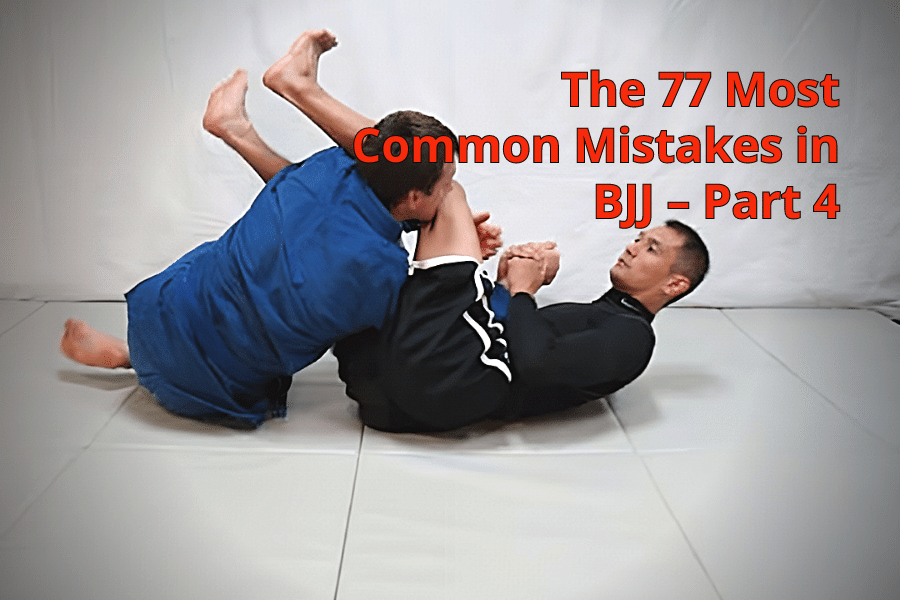
Table of Contents
- BJJ MISTAKE 56- Bottom Mount Buck and Roll: Only Turning to the Side
- BJJ MISTAKE 57- Guard Replacement: Shrimping without Shoving
- BJJ MISTAKE 58- Kesa Gatame: Not Being 90 Degrees to Your Training Partner.
- BJJ MISTAKE 59- Top Cross Side Armbar: Grabbing the Arm
- BJJ MISTAKE 60- Rear Naked Choke: Hand on the Top of His Head
- BJJ MISTAKE 61- Ankle Lock: Executing It Too Soon
- BJJ MISTAKE 62- Ankle Lock: Not Attacking the Achilles Tendon
- BJJ MISTAKE 63- Ankle Lock: Not Applying Force With the Wrist
- BJJ MISTAKE 64- Armbar: Not Driving Your Heels to the Mat
- BJJ MISTAKE 65- S Mount: Heel Far From the Belt
- BJJ MISTAKE 66- Double Leg Takedown: Eyes to the Floor
- BJJ MISTAKE 67- Bow and Arrow Choke: The Hip and the Hand
- BJJ MISTAKE 68- Guard: The 4 Things You Should Do- Most People Only Do One.
- BJJ MISTAKE 69- Not Sharing Information With Others
- MISTAKE 70- Using Too Much Strength
- MISTAKE 71- Omitting the Mental Training
- MISTAKE 72- Not Teaching Yourself a Technique
- MISTAKE 73- Only Learning From the Higher Belts
- MISTAKE 74- Fearing the Tap Out
- MISTAKE 75- Being Fixated on Belt Promotions
- MISTAKE 76- Too Much Drilling or Too Much Sparring
- MISTAKE 77- Only Going to Group Classes
- Conclusion
- Continue Reading
Make your BJJ better and start reading here:
The 77 Most Common Mistakes in Brazilian Jiu Jitsu – Part 1
BJJ MISTAKE 56- Bottom Mount Buck and Roll: Only Turning to the Side
A common mistake is to only roll as you execute the Buck and Roll Escape from Bottom Mount.
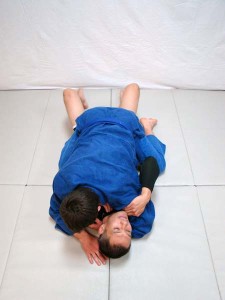
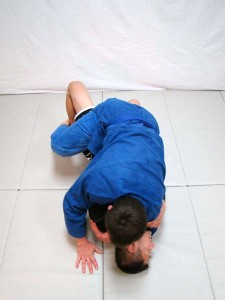
The key to making the Buck and Roll Escape work is to imagine you are trying to make your training partner hit the mat with his forehead.
You want to turn your head so you can look to the mat and then bridge your training partner up over your head.



BJJ MISTAKE 57- Guard Replacement: Shrimping without Shoving
Many people as they attempt to maintain their Guard and defend the Guard Pass, only shrimp away to create distance.
Or they’ll only push their training partner away to stop them from driving forward.
The proper way to defend the Guard Pass, and to create enough space to keep your legs in front of you, is to shrimp AND push him away. You need to do both to be effective.


Shrimp and shove and you’ll be able to keep your Guard more often.
BJJ MISTAKE 58- Kesa Gatame: Not Being 90 Degrees to Your Training Partner.
When people maintain Kesa Gatame (aka, Sitting Side Mount) they are typically too close to their training partner’s hips or they’re too far away..


The strongest way to maintain Top Cross Side is to have your spine perpendicular to your training partner’s spine.

Since Kesa Gatame is another form of Top Cross Side, it is important to do the same and maintain 90 degrees between your spine and his spine; otherwise, you could facilitate an easy escape for your training partner.
BJJ MISTAKE 59- Top Cross Side Armbar: Grabbing the Arm
People who believe it is necessary to grab the arm to do an Armbar from Top Cross Side are misinformed.

Grabbing onto the arm that you plan to attack only alerts your training partner to your impending submission.
Instead, just lay your arm under his arm. Make it look like you are going for a choke or an Americana on the opposite arm and when he least suspects it, throw your leg over his head for a quick Armbar.

BJJ MISTAKE 60- Rear Naked Choke: Hand on the Top of His Head
Placing the hand on the back of your opponent’s head to finish the Rear Naked Choke is a mistake.

A basic counter is to grab a hand – any hand – the most available of which is the hand mistakenly placed on top of the head.

Instead of having your hand on the back of your training partner’s head, hide your forearm behind your opponent’s neck and place your hand on your own shoulder.

Doing so will amplify the squeezing power of your choke and it will be more difficult for your training partner to counter the choke.
BJJ MISTAKE 61- Ankle Lock: Executing It Too Soon
Many people make the mistake of executing the ankle lock by first encircling the ankle with their wrist and then falling back before having the proper positioning with their feet.

You can tell when people make this mistake because their Ankle Lock attempts are easily foiled by their training partner being able to sit up and dissolve the Lock.

The proper way to do an Ankle Lock is to control your opponent’s ankle between your elbow and your rib cage.

If you are standing, you can even sandwich the ankle between your rib cage and your thigh and clamp everything together with your elbow.
Do not wrap your arm around the ankle. This only alerts your training partner that you are going for an Ankle Lock and he’ll defend it immediately.
Once you have secured the ankle by hugging his shin, then fall back and place your feet in the proper position so that your training partner can not sit up and defend.

Now, only once you have control of your training partner’s hips and upper leg, and he cannot roll, sit up or get away, then go and bring your wrist under his Achilles tendon to execute the lock.

BJJ MISTAKE 62- Ankle Lock: Not Attacking the Achilles Tendon
When going for an Ankle Lock many people place their wrist too high up on the calf muscle.
Most people will not tap when pressure is applied to the calf muscle.
The proper placement of your wrist is against the wrinkles of his heel.


When your training partner points his toes, wrinkles will form where his Anchilles Tendon ends and his heel begins. This is where you want to place your wrist to execute the Ankle Lock.
BJJ MISTAKE 63- Ankle Lock: Not Applying Force With the Wrist
A common mistake when going for the Ankle Lock is using your forearm. Especially the portion of the arm that is close to the elbow.
The correct way to do the Ankle Lock is to use the part of your wrist that your wrist watch typically rests on.
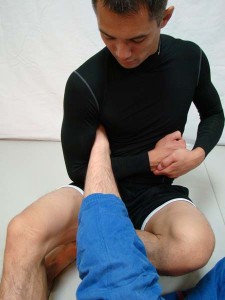
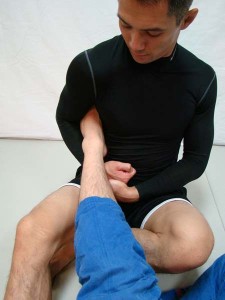
This part of you forearm is bonier and force will be directly transmitted into the Achilles Tendon of your training partner, thus making it far more painful.
BJJ MISTAKE 64- Armbar: Not Driving Your Heels to the Mat
When people go for an Armbar, they are often lazy with their legs.
When they fall back to execute the Armbar, they let their heels fly up into the arm.


This only allows your training partner to sit up and counter the Armbar.
If he can sit up, he will wind up in your Guard where he can escape easier.
You need to stomp your heels to the mat, thus pinning him down and preventing him from sitting up.

BJJ MISTAKE 65- S Mount: Heel Far From the Belt
When fighting from Top Mount many people make the mistake of being lazy with their legs. Their heels are too far away from their training partner’s sides.
If there is space between your heel and his hip, your training partner on the bottom has an easy Elbow/Knee Escape and can put your back in his Half Guard.


Keep your heel tight to him.
BJJ MISTAKE 66- Double Leg Takedown: Eyes to the Floor
Many people keep their eyes to the ground when they are attacking with a Double Leg Takedown.


This critical error opens you up for an easy sprawl or you will get countered with a Guillotine.
Keep your eyes to the sky and it will be much harder for your opponent to slap a Guillotine on you.


BJJ MISTAKE 67- Bow and Arrow Choke: The Hip and the Hand
When applying the Bow and Arrow Choke, it is important to have your hips as high up on his torso as possible. You are basically wrapping your Guard around his shoulders.
If he is flexible and if he has a long torso, when you just have your hips over his belt line, he will be able to adjust his positioning and resist the choke.
When he is being controlled around his shoulders by your Guard, there is no way he can adjust his positioning.

As well, you need to control his leg by hooking it with your elbow. It is much more difficult to attain. Just grabbing his leg with your hand is much easier, but it does not offer the same level of control as does your elbow hooking his leg.
BJJ MISTAKE 68- Guard: The 4 Things You Should Do- Most People Only Do One.
From the Guard, there are 4 things you can do.
- Submit – go for a choke, an Armbar, or a Kimura
- Sweep – go from a bottom position to a top position
- Take the back – transition to a much more offensive position
- Stand up – push him away with your feet to create space, sit up, and then get back up to your feet
These 4 choices are true for any type of Guard- Half Guard, Closed Guard, X Guard, etc.
Put these four offensive strategies into combination and you’ll be much more successful from your Guard.
BJJ MISTAKE 69- Not Sharing Information With Others
A common disease found in many martial arts academies is the inability of fellow classmates to share technical knowledge, strategies and developing game plans with other students.
I find this problem is especially rampant in BJJ schools. In Jiu Jitsu, knowledge is a weapon.
Many times you can tap out one of your training partners with a technique that they’ve never seen before. Since they’ve never seen it before, they’ll have no idea how to defend it or counter it.
Because people want to continue to tap the other students out, they will be unwilling to share their knowledge with others in fear that they will have their tactics used against them. The ironic thing is that you will actually attain a higher degree of skill and proficiency the more you share and the more you teach.
When you share a technique with someone, teach them everything about it. Show them how to do it and how to set it up and even show them how to counter it. Now, when you attempt the technique on them during sparring, they will know how to intelligently defend it and you will have to have a secondary attack ready to counter their defense.
This is how your game grows and develops.
When they try to execute the technique on you, they may discover a variation on the technique that is just as valid as the one you showed them and now your knowledge expands.
For something to grow it needs to have light. If you just keep it in the dark, nothing will grow. Share what you know and your knowledge and skill will expand.
MISTAKE 70- Using Too Much Strength
Remember, Jiu Jitsu is about exercising principles of leverage, proper body positioning and timing. Jiu Jitsu is not another avenue for you to demonstrate how strong and aggressive you are.
That being said, being strong and explosive will absolutely help you and if you are rolling with someone who greatly outweighs you or with someone who is much stronger than you, because it becomes extremely more difficult to work your offensive techniques. Ultimately, size and strength do matter.
To truly embrace the magic of BJJ you need to pretend that you are 80 years old. Without the aid of your power or your strength, the only way you can submit or sweep your training partner is to have perfect body positioning all the while utilizing precise timing.
Take out the strength and your Jiu Jitsu will become far more technical.
MISTAKE 71- Omitting the Mental Training
Is mental training important for fighting? How much of fighting is mental? 10%? Maybe 50%? How about 90%
Let me ask you, how much time you spend on your mental training? How much time do you spend visualizing your attacks? How long will you spend shadow boxing, or in this case “shadow wrestling” your moves? How much energy do you spend on dissolving your fears or insecurities? I mean, training martial arts can be a very intimidating thing.
For any athletic endeavour, whether it’s BJJ, Boxing, or Volleyball, there are 3 vital components:
- Physical- muscular strength, muscular endurance, cardiovascular endurance, agility, balance, bone/muscle/fat ratio, flexibility
- Technical- precise timing, proper positioning, correct distance and range, proper execution of the technique, the correct technique for the correct problem
- Mental- ability to focus on the task at hand, ability to deal with failure or setbacks, the discipline to do what you do not like doing
All three are important. Think of these three components as a tripod. If one of these components were to fall, then everything will fall.
Just as you can be beat if you are super technical, mentally strong but physically out f shape, so too can you go down if you are technical and fit, but your mind is not in the game.
You need to work on all three components in order to be truly successful. Most people only work on one component, two at the most.
MISTAKE 72- Not Teaching Yourself a Technique
Often, when I’m watching UFC or when I’m watching tournament footage on Youtube of highly esteemed BJJ practitioners, I’ll see a technique that I’m not familiar with. Typically, what I do is I call up one of my training partners or I grab one of my students and we get together and try to figure out the details of the attack.
First, we just try and duplicate what we saw. We associate the technique with one that we already know and then we break down the similarities and the differences. We try out the technique and we ask each other questions like: How does it feel this way versus the other way? Which way has more leverage? Which way offers more control? Which way is more simpler to execute?
Then we try to think of 3 or 4 variations of the technique.
And then we try to think of ways to counter it.
We also develop different set up strategies and different follow ups in case the technique doesn’t work.
Doing all of this is important because it will further illuminate all the subtleties of the technique when you develop variations, counters, escapes, entries and follow ups to it.
Doing these things help you dissect the technique and fully understand it.
Finally, as soon as possible, I teach the technique. I recommend that you teach it to anyone who will listen. When you teach something, you will be forced make sense of it more clearly and more completely and through the questions that someone else may ask, you will construct a more comprehensive view of the technique.
You do not need to have someone teach you a technique just to be able to use it. Martial arts are self teaching. You can figure out how everything works all on your own. Having a teacher by your side only helps you figure out the information faster. He can show you in 5 minutes what could take you months or years to figure out on your own.
But, the lesson here is that you can figure it out on your own and at times it’s better that way because the knowledge you retain will be deeper and more complete.
MISTAKE 73- Only Learning From the Higher Belts
Many people feel that they can only learn from training with the senior students.
While it is true that the senior student can offer advice, knowledge, encouragement and inspiration, it is by developing students at a lower level than you that you will be able to embrace aspects of mentoring, teaching, and leadership.
As well, training with students at a lower level than you will allow you to exercise your offensive tactics. It’s really difficult to work an Armbar from Mount with a guy who’s been training for 3 years while you’ve only been training for 6 months. As well, you can share your knowledge with someone who is not as skillful as you.
Teaching something is one of the best ways to truly understand it.
The rich diversity of a group class setting is where you can explore, learn and share all aspects of BJJ. Everybody in the room is equally valuable and equally important, from the senior student to the person just learning to tie their belt. Everybody can teach you something.
MISTAKE 74- Fearing the Tap Out
Many people are too intimidated to try out new techniques and expand their game because they are too worried about getting tapped out. This causes individuals only to continually execute techniques that have worked for them in the past. Sometimes, I train with guys who I haven’t trained with in years, and it’s amazing, it’s like I just went back in time. They will execute the same attacks that they were doing years ago. Now that doesn’t mean that the techniques are irrelevant or that they don’t work, it’s just that their game has not expanded. Doing the same thing again and again will eventually lead to you being predicable, and thus easily, countered.
I tell my students that the path to being a black belt in BJJ consists of 10, 000 taps. You have to tap out 10,000 times in order to become a black belt. You have to explore different attack strategies, perfect your defensive positions, practice your escapes and train things that you are not good at. Only then will you be growing and exploring and developing your game.
Remember, there is no such thing as winning. And there is no such thing as losing. There is only learning. Learn. Expand and grow and get tapped out doing new things.
MISTAKE 75- Being Fixated on Belt Promotions
There are two types of motivation: external and internal
External motivation means that you do this for the money, for the accolades, for a piece of paper or for a trophy.
Internal motivation means you do things because you love it. You love playing soccer, or playing music or learning new languages. You do it because it makes you genuinely happy. And you do it purely for the pursuit of exercising your gifts and to fully stretch every facet of your character. You are doing it for self betterment and for excellence.
Belts, unfortunately, ignite your external motivations. I do give belt promotions out at my academy; however, it is done more out of tradition than anything else.
In every way possible, I try to promote an internal sense of motivation for all of my students.
MISTAKE 76- Too Much Drilling or Too Much Sparring
Most martial arts schools will fall into 2 catagories:
Those who mostly drill
Those who mostly spar
Those who mostly drill will have excellent technical execution, proper body positioning, great coordination, and a deep understanding of what they are doing. The problem comes when they try and spar the technique against a training partner that is resisting completely. They can’t seem to functionalize it. They can not make on-the-fly adjustments. They have no adaptability or problem solving skills and they can not execute the technique in a dynamic, constantly changing scenario.
Those who spar a lot have great timing; they have great balance and an intuitive idea of where their limbs are and where their opponent’s limbs are. They can transition well from position to position and they have a strong stomach for adversity and stress. Unfortunately, they’re typically injured a lot of the time. Hard rolling is tough on your body and when you get two people aggressively attacking for sweeps and submissions, accidents can happen.
As well, those who spar a lot are not very technically proficient. Their body positioning is slightly off for their sweeps. Or their weight distribution for their Guard Passing is awkward. Or their Armbar execution is a bit sloppy.
When someone starts to study martial arts they go through a typical process:
- They learn the technique
- They practice the technique
- They master the technique
- And then they functionalize it in sparring.
The 4th phase, functionalizing the technique, is where many people hit a wall. People learn that not every technique works all the time and that everything can be countered.
People lose faith in themselves. And have a hard time dealing with “not being able” to do something.
That is why many people just drill. It makes them feel successful.
On the opposite end of the spectrum, there are many people that will just spar. Drilling is boring and repetitive. Sometimes it feels like it is so disconnected, it has nothing to do with fighting at all.
The answer is to drill in a manner that is repetitive enough to attain technical perfection while being dynamic enough to replicate a chaotic and engaging sparring session. Leaving out the injuries, the boredom and the sense of failure.
MISTAKE 77- Only Going to Group Classes
Most people only go to group classes. There are 5 things everybody needs to do to supercharge their training. All are equally important. None can be omitted.
1. Private, one on one instruction
Martial arts can only be learned from person to person. Subtle nuances can be lost in the translation. You have to feel an Armbar from a competent practitioner to truly understand and respect the technique. Everyone learns differently and at different rates, a specific curriculum ought to be designed for the individual student.
2. Group class participation
Everyone moves differently. Everyone has different talents and shortcomings. No two people have the exact same physical makeup. To truly study martial arts, one must prepare for any possible scenario. Therefore, one must prepare for any type of opponent. Train with as many different people as possible. Everyone will offer you a different problem. The more solutions you are able to provide, the better prepared you will be.
3. A training partner
Understand that group class and private sessions are not times to practice. Classes are occasions for learning, where information is imparted. Practice occurs during time spent away form class, on your own or with a training partner.
Learning martial arts is a social activity; to be competent at fighting skills you need the help of others. Take my arm, practice breaking it. Take my neck, practice choking me unconscious. Martial arts training offers a level of intimacy between practitioners that few activities can rival. Where else can you find someone who may be willing to offer you one of their favourite limbs or sacrifice their general physical health for your self betterment? Trust is the bond that makes the reciprocity between training partners possible. To illustrate, look at the scenario whereby two training partners are practicing ankle lock attacks. My assurance that no harm is going to come to me as I offer you my foot is reciprocated as I, in return, receive your ankle to perfect my attacks. Martial arts training is an analogy for any healthy relationship. Training partners exercise a system of give and take; practitioners form a relationship of interdependence and mutual reliance. An interesting paradox emerges: only through kindness and benevolence to my training partner can I become more violently and aggressively proficient towards my adversary.
4. Solo practice
Solo practice is simply another term used to describe shadow boxing. You can use your imagination to recreate an actual sparring scenario and thus, make your decision making faster. Some of the greatest athletes in the world – Michael Jordan, Wayne Gretzky – were not the fastest and most explosive guys out there; but, they could make decisions faster and their decisions as to what to do where typically correct.
Sparring and training martial arts can be a fearful experience for many. Mentally rehearsing the match in your head can help you find a greater sense of calm and a stronger sense of emotional control.
Often when we solo practice we are merely repeating a specific movement. We are throwing out our jab and our cross, being mindful of our form, but not visualizing the impact we may have on our imaginary opponent. To truly highlight the benefits of solo practice, athletes must utilize their imagination to create a fictitious combative scenario.
Athletes need to recreate the scenario as vividly and as realistically as possible. The mind is like a VCR. According to Dr. Gary Mack, author of Mind Gym, “The human body treats every vivid thought and image as if it is real and happening now. Everyone who has awakened from a nightmare knows this to be true.”
Ask yourself…
– Where are you?
– What time of day is it?
– What time of year is it?
– What are you wearing?
– Who is your opponent?
– Is there only one?
– What do they look like?
– How are they moving?
– What are they saying?
– How do you feel emotionally?
– How are they attacking you?
– How are you attacking them?
– How are they responding?
– What do you hear?
– Who is watching?
– Who is with you?
To bolster your confidence you need to always visualize a successful and victorious scenario. Building mental muscle, like building physical muscle takes time and effort. The more you work on the inside, the more it will show on the outside.
Your brain can not decipher whether you’ve actually executed a physical act or just recreated it in your head. The key to mental training is to recreate the training scenario as vividly in your head as possible. Everything to how you feel physically, how smelly the gloves are, how your training partner looks, what the gym or training environment looks like. The more vivid your thoughts, the better in fooling your brain that you actually, physically did the training.
The beauty of mental training is that you can do it anywhere: on the bus, at home on the coach while you’re recovering from a shoulder injury, or when you’re walking on the beach.
Do you believe that the mental part of the game is important? Maybe 50 % of the game. Maybe even as high as 90%. If so, how much time to you spend on your mental training?
5. Teach it
When you teach something, you basically learn it twice. Through the questions your “students” will ask you, you will understand the subject deeper and more completely. By teaching someone what you have learned, whether a drill or a new technique, you instantly have a training partner.
Conclusion
This was certainly not an exhaustive list of the typical mistakes you’ll see in a BJJ classroom. My list of 77 mistakes is summation of the most common sticking points I see on a regular basis. I hope this article was helpful. If you’ve experienced other common BJJ mistakes please feel free to add them to the comments section below.
Continue Reading
- The 77 Most Common Mistakes in Brazilian Jiu Jitsu – Part 1
- The 77 Most Common Mistakes in Brazilian Jiu Jitsu – Part 2
- The 77 Most Common Mistakes in Brazilian Jiu Jitsu – Part 3
- The 77 Most Common Mistakes in Brazilian Jiu Jitsu – Part 4



